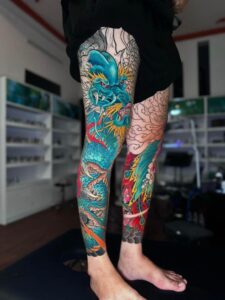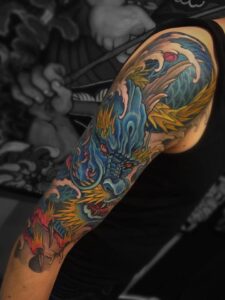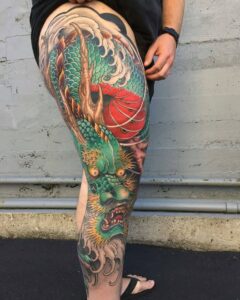The Art and History of Traditional Japanese Tattoos
Traditional Japanese tattoos, known as Irezumi, are a captivating art form that has endured for centuries. These tattoos are not just visually stunning but also carry deep cultural significance and history. This blog explores the rich history, cultural impact, and modern-day perceptions of traditional Japanese tattoos. We’ll also discuss the positive and negative aspects of these tattoos, along with their symbolic meanings.

Introduction to Traditional Japanese Tattoos
Traditional Japanese tattoos, also known as “Irezumi,” are a profound and enduring art form with roots that stretch back centuries. These tattoos are more than just a form of body art; they are a reflection of cultural values, spiritual beliefs, and personal identity. The intricate designs and bold imagery of traditional Japanese tattoos have captivated people worldwide, leading to a deep appreciation for this ancient art form.
The term “Irezumi” literally means “inserting ink” in Japanese, and it perfectly encapsulates the essence of traditional Japanese tattoos. These tattoos are typically large-scale works that cover significant portions of the body, such as the back, arms, and legs. Each design is meticulously crafted, often taking years to complete due to the level of detail and the traditional methods used.


The History of Traditional Japanese Tattoos
Early Origins and Cultural Significance
The history of traditional Japanese tattoos dates back to ancient times, with evidence of tattooing practices found in artifacts and historical records from Japan’s Jomon period (around 10,000 BC to 300 BC). Initially, tattoos were believed to have been used as spiritual symbols, offering protection and marking rites of passage. They were also associated with various social roles, such as indicating a person’s status within the community.
As time progressed, the cultural significance of tattoos in Japan evolved. By the Edo period (1603-1868), tattoos became a prominent form of artistic expression, with intricate designs often inspired by woodblock prints, folklore, and religious iconography. This period marked the rise of Irezumi as a revered art form, with master tattoo artists, known as horishi, developing their unique styles and techniques.


Association with the Yakuza and Societal Perceptions
During the Edo period, traditional Japanese tattoos also became associated with the criminal underworld, particularly the Yakuza, Japan’s organized crime syndicates. Tattoos were used by the Yakuza as a way to signify loyalty and membership within the organization. This association with criminal activity led to a societal stigma surrounding tattoos, which continues to some extent in modern Japan.
Despite this stigma, traditional Japanese tattoos have remained a respected and admired art form. Many people, both in Japan and abroad, are drawn to the rich symbolism and aesthetic beauty of these tattoos, viewing them as a powerful means of personal expression.
Symbolism in Traditional Japanese Tattoos
Common Motifs and Their Meanings
Traditional Japanese tattoos are known for their rich symbolism, with each design carrying deep cultural and spiritual meanings. Some of the most common motifs in traditional Japanese tattoos include:
- Dragons: Symbolizing strength, wisdom, and protection, dragons are one of the most popular motifs in traditional Japanese tattoos. They are often depicted as powerful, serpent-like creatures with flowing manes and sharp claws, embodying the forces of nature.
- Koi Fish: Koi fish are a symbol of perseverance, determination, and success. In Japanese mythology, koi fish are said to swim upstream and transform into dragons, making them a powerful representation of overcoming challenges and achieving one’s goals.
- Cherry Blossoms: Cherry blossoms, or “sakura,” are a symbol of the transient nature of life. Their fleeting beauty serves as a reminder of the impermanence of all things, making them a popular choice for those who wish to reflect on the delicate balance between life and death.
- Tigers: Tigers are often depicted in traditional Japanese tattoos as symbols of courage, strength, and protection. They are believed to ward off evil spirits and bring good fortune to those who wear them.


The Spiritual and Protective Aspects of Traditional Japanese Tattoos
In addition to their aesthetic appeal, traditional Japanese tattoos are also believed to have spiritual and protective qualities. Many designs are infused with religious and mythological significance, serving as talismans to ward off evil, bring good luck, or protect the wearer from harm. For example, tattoos featuring Buddhist deities or Shinto spirits are often chosen for their protective powers, while images of sacred animals like dragons and tigers are believed to embody the strength and wisdom of these revered creatures.
The Tebori Technique: Traditional Japanese Tattooing Method
Explanation of the Tebori Hand-Poking Technique
One of the defining characteristics of traditional Japanese tattoos is the method by which they are created. The technique, which translates to “hand carving,” is a traditional tattooing method that has been passed down through generations of Japanese tattoo artists. This technique involves manually inserting ink into the skin using a hand-held tool with needles attached to the end.
The method is distinct from modern tattooing techniques that use electric machines. It requires immense skill and precision, as the artist must control the depth and angle of each needle stroke to achieve the desired effect. This technique allows for greater variation in line thickness and shading, resulting in a more dynamic and textured tattoo.

Comparison with Modern Tattooing Methods
While modern tattoo machines are faster and less physically demanding, many traditional Japanese tattoo artists continue to use the technique to maintain the authenticity and integrity of their work. The method is revered for its ability to create deep, vibrant colors and intricate details that are difficult to achieve with machine tattooing. However, the process is also more time-consuming and often more painful, as it involves manually puncturing the skin with each stroke.
Cultural Importance of Traditional Japanese Tattoos
The Role of Tattoos in Japanese Culture and Spirituality
Traditional Japanese tattoos have played a significant role in Japanese culture and spirituality for centuries. In addition to their aesthetic appeal, these tattoos are deeply connected to Japanese beliefs about the nature of life, death, and the spiritual world. They often serve as a form of protection, a way to honor the gods, or a means of expressing one’s inner self.
For example, tattoos of Buddhist deities or symbols are often chosen to invoke spiritual protection or to demonstrate one’s devotion to the teachings of Buddhism. Similarly, tattoos of Shinto spirits or kami are selected to honor these sacred beings and to seek their guidance or blessings. This spiritual connection adds another layer of meaning to traditional Japanese tattoos, making them much more than mere decorations on the skin.


How Traditional Japanese Tattoos Reflect Personal Stories and Beliefs
Traditional Japanese tattoos are often deeply personal, reflecting the wearer’s life story, beliefs, and values. Each element of the tattoo is carefully chosen to convey a specific message or to symbolize an important aspect of the wearer’s identity. For example, someone might choose a dragon tattoo to represent their strength and resilience, while another person might select a koi fish to symbolize their journey through life’s challenges.
These tattoos are also used to mark significant life events, such as overcoming a difficult period, achieving a major goal, or honoring a loved one. The deeply symbolic nature of traditional Japanese tattoos means that each piece is unique to the individual, with its design and meaning tailored to their personal experiences and aspirations.
Modern Interpretations of Traditional Japanese Tattoos
The Influence of Traditional Japanese Tattoos on Global Tattoo Culture
Traditional Japanese tattoos have had a profound influence on tattoo culture worldwide. Their bold designs, intricate details, and deep symbolism have inspired countless artists and enthusiasts across the globe. As a result, elements of traditional Japanese tattooing have been incorporated into a wide range of styles, from Western traditional to neo-Japanese and beyond.
This global influence has led to the creation of fusion styles that blend traditional Japanese motifs with modern techniques and aesthetics. These contemporary interpretations often retain the core elements of traditional Japanese tattoos—such as dragons, koi fish, and cherry blossoms—while incorporating new themes, colors, and styles.


Fusion Styles and Contemporary Adaptations
In modern tattooing, traditional Japanese designs are often adapted to suit contemporary tastes and preferences. This might involve combining traditional motifs with modern imagery, using brighter colors, or experimenting with different tattooing techniques. Some artists might even reinterpret traditional themes in a more abstract or minimalist style, creating a unique blend of old and new.
While these adaptations can result in stunning and innovative tattoos, it’s important to approach them with respect for the cultural and historical significance of traditional Japanese tattoos. By understanding the meanings behind the symbols and the techniques used, both artists and clients can create tattoos that honor the traditions they are based on while still allowing for personal expression and creativity.
Positive Aspects of Traditional Japanese Tattoos
Artistic Value and Cultural Richness
One of the most significant positive aspects of traditional Japanese tattoos is their incredible artistic value. These tattoos are masterpieces of design and craftsmanship, with each piece reflecting the skill and creativity of the artist. The bold lines, intricate details, and vibrant colors of traditional Japanese tattoos make them stand out as some of the most visually striking forms of body art in the world.
Beyond their aesthetic appeal, traditional Japanese tattoos are also rich in cultural significance. Each design is steeped in symbolism, drawing on centuries of Japanese history, mythology, and spiritual beliefs. This cultural depth adds a layer of meaning to the tattoos, making them not just beautiful works of art, but also powerful expressions of identity, values, and heritage.

Sense of Identity and Personal Expression
Traditional Japanese tattoos offer a unique way for individuals to express their identity and beliefs. Whether it’s through the choice of a specific motif, the use of particular colors, or the overall design of the tattoo, these pieces allow people to communicate their personal stories in a visually compelling way. For many, getting a traditional Japanese tattoo is a deeply meaningful experience that connects them to a rich cultural heritage and allows them to embody the qualities represented by their chosen symbols.
Global Appreciation of Traditional Japanese Tattoo Art
In recent years, there has been a growing global appreciation for the art of traditional Japanese tattoos. Enthusiasts from around the world are drawn to the unique blend of artistry, symbolism, and cultural depth that these tattoos offer. This increased interest has led to a greater understanding and respect for the traditions and techniques behind Japanese tattooing, helping to preserve and promote this ancient art form on a global scale.


Negative Aspects of Traditional Japanese Tattoos
The Stigma Associated with Tattoos in Japan
Despite their beauty and cultural significance, traditional Japanese tattoos are still subject to a certain level of stigma in Japan. This is largely due to their historical association with the Yakuza, Japan’s organized crime syndicates, which has led to a perception of tattoos as being linked to criminal activity. As a result, people with tattoos may face discrimination or exclusion from certain public places, such as baths, gyms, and beaches.
While attitudes towards tattoos are slowly changing, particularly among younger generations, this stigma can still pose challenges for those who choose to get traditional Japanese tattoos. It’s important for anyone considering such a tattoo to be aware of the potential social implications, especially if they plan to live or travel in Japan.
Challenges in Preserving Authenticity and Tradition
As traditional Japanese tattoos gain popularity worldwide, there is a growing concern about preserving the authenticity and integrity of this art form. The increasing demand for traditional Japanese designs has led to the rise of artists who may not be fully trained in the techniques and cultural significance of these tattoos. This can result in tattoos that, while visually similar, lack the depth of meaning and authenticity that true traditional Japanese tattoos possess.


Preserving the tradition of Japanese tattooing requires a deep respect for the history, techniques, and cultural context of this art form. Artists and clients alike must be committed to understanding the symbolism behind each design and to honoring the traditions that have shaped this unique style of tattooing.
The Issue of Cultural Appropriation
With the global popularity of traditional Japanese tattoos comes the risk of cultural appropriation. This occurs when elements of one culture are adopted or used by members of another culture, often without a full understanding or respect for their original significance. In the context of traditional Japanese tattoos, this can happen when people choose designs purely for their aesthetic appeal, without considering the cultural meanings behind them.
Cultural appropriation can be harmful because it often involves taking sacred or meaningful symbols out of their original context and using them in ways that are disrespectful or superficial. To avoid this, it’s important for those interested in traditional Japanese tattoos to educate themselves about the culture and history behind these designs and to approach them with the respect they deserve.
The Tebori Experience: Pain, Process, and Aftercare
What to Expect During a Tebori Tattoo Session
The experience of getting a Tebori tattoo is unique and differs from modern tattooing methods. Because the Tebori technique is performed by hand, it can be more time-consuming and often requires multiple sessions to complete a large design. During the session, the artist will use a hand-held tool to insert the ink into the skin, a process that requires precision and care.
Many people find the Tebori method to be more painful than machine tattooing, as the hand-poking technique involves deeper punctures and more pressure. However, the results are often worth the discomfort, as Tebori tattoos are known for their rich colors, smooth gradients, and intricate details.


Pain Levels and Healing Process
The pain associated with Tebori tattooing can vary depending on the location of the tattoo and the individual’s pain tolerance. Areas with more flesh, like the back or thighs, tend to be less painful than areas with thinner skin, such as the ribs or hands. The healing process for a Tebori tattoo is similar to that of any other tattoo, requiring proper aftercare to ensure the best results.
After the tattoo is completed, it’s important to keep the area clean and moisturized, avoid sun exposure, and follow any specific instructions given by your artist. Proper aftercare will help to prevent infection and ensure that the tattoo heals beautifully, preserving the vibrancy and detail of the design.
Proper Aftercare for Traditional Japanese Tattoos
Caring for a traditional Japanese tattoo involves following the standard tattoo aftercare procedures, but with an emphasis on maintaining the integrity of the Tebori work.